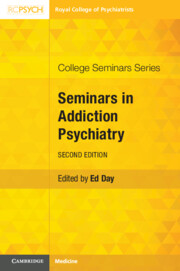Book contents
- Seminars in Addiction Psychiatry
- College Seminars Series
- Seminars in Addiction Psychiatry
- Copyright page
- Contents
- Contributors
- Preface
- Chapter 1 Historical and Conceptual Approaches to Addiction
- Chapter 2 Illicit Drug Use: Epidemiology, Aetiology and Prevention
- Chapter 3 Illicit Drug Use: Clinical Features and Treatment
- Chapter 4 Addiction to Prescription Medication: Benzodiazepines, Z-Drugs and Gabapentinoids
- Chapter 5 Alcohol Use Disorders: Epidemiology and Prevention
- Chapter 6 Alcohol Use Disorders: Aetiology and Pathophysiology
- Chapter 7 Alcohol Use Disorders: Clinical Features and Treatment
- Chapter 8 Psychological Approaches to Addiction
- Chapter 9 Comorbid Substance Use and Mental Illness
- Chapter 10 Medical Aspects of Drug and Alcohol Use
- Chapter 11 Organising Treatment Services for Drug and Alcohol Misusers
- Chapter 12 Tobacco Use Disorders
- Chapter 13 Novel Psychoactive Substances and Club Drugs
- Chapter 14 Addiction Problems in a Family and Social Context
- Chapter 15 Addiction Recovery Mutual-Aid Organisations
- Index
- References
Chapter 4 - Addiction to Prescription Medication: Benzodiazepines, Z-Drugs and Gabapentinoids
Published online by Cambridge University Press: 02 November 2021
- Seminars in Addiction Psychiatry
- College Seminars Series
- Seminars in Addiction Psychiatry
- Copyright page
- Contents
- Contributors
- Preface
- Chapter 1 Historical and Conceptual Approaches to Addiction
- Chapter 2 Illicit Drug Use: Epidemiology, Aetiology and Prevention
- Chapter 3 Illicit Drug Use: Clinical Features and Treatment
- Chapter 4 Addiction to Prescription Medication: Benzodiazepines, Z-Drugs and Gabapentinoids
- Chapter 5 Alcohol Use Disorders: Epidemiology and Prevention
- Chapter 6 Alcohol Use Disorders: Aetiology and Pathophysiology
- Chapter 7 Alcohol Use Disorders: Clinical Features and Treatment
- Chapter 8 Psychological Approaches to Addiction
- Chapter 9 Comorbid Substance Use and Mental Illness
- Chapter 10 Medical Aspects of Drug and Alcohol Use
- Chapter 11 Organising Treatment Services for Drug and Alcohol Misusers
- Chapter 12 Tobacco Use Disorders
- Chapter 13 Novel Psychoactive Substances and Club Drugs
- Chapter 14 Addiction Problems in a Family and Social Context
- Chapter 15 Addiction Recovery Mutual-Aid Organisations
- Index
- References
Summary
Benzodiazepines, Z-drugs and gabapentinoids are commonly prescribed medications with multiple indications that have the potential for misuse and dependence. Benzodiazepines enhance the effect of the neurotransmitter gamma-aminobutyric acid (GABA) at the GABA-A receptor, resulting in sedative, anxiolytic, hypnotic, anticonvulsant and muscle relaxant properties. The ‘Z-drugs’ (zopiclone and zolpidem) are non-benzodiazepine hypnotics that also have an agonist effect at the GABA-A receptor. The gabapentinoids (pregabalin and gabapentin) act to decrease central neuronal excitability by binding to α2-δ protein subunits of voltage-activated calcium channels on the neuronal membrane. They were initially marketed as antiepileptic drugs, but are now licensed for use in neuropathic pain and generalised anxiety disorder. This chapter considers each class in turn, exploring the pharmacokinetics, metabolism and potential desired effects that lead to misuse. A practical method for assessing people with potential dependence is described for each substance, as well as strategies to support stabilisation, withdrawal and relapse prevention.
Keywords
- Type
- Chapter
- Information
- Seminars in Addiction Psychiatry , pp. 68 - 96Publisher: Cambridge University PressPrint publication year: 2021
References
- 1
- Cited by

